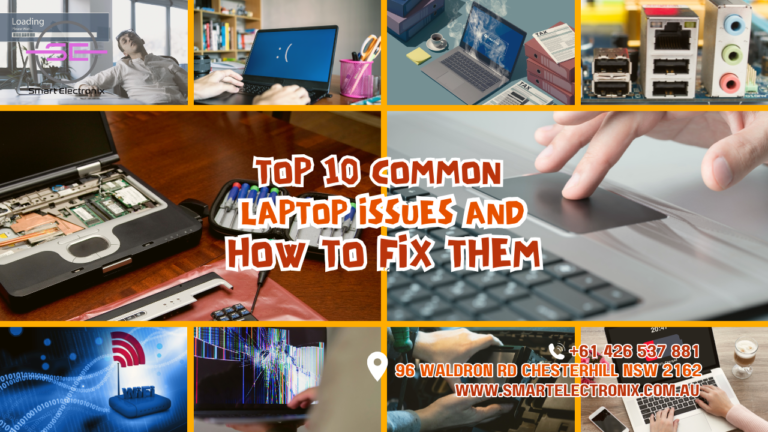
Laptops have become a vital component of our everyday routines, serving as indispensable tools for work, education, and entertainment. But just like any electronic device, they can develop issues over time. Some problems are minor and easy to fix, while others may require professional help. At Smart Electronix, we specialize in diagnosing and repairing laptops, ensuring they run smoothly. In this blog, we’ll explore the top 10 most common laptop problems and provide practical solutions to fix them.
1. Slow Performance
One of the most common complaints among laptop users is sluggish performance. This can be caused by too many background programs, fragmented files, malware, or insufficient storage.
How to Fix:
- Uninstall unnecessary programs and disable startup apps.
- Perform disk cleanup and defragment your hard drive regularly.
- Install a reliable antivirus program and perform a full system scan.
- Upgrade your RAM or switch to an SSD for faster processing.
2. Overheating and Fan Noise
Excessive heat can slow down your laptop and even damage internal components. It’s usually caused by dust buildup, blocked vents, or an aging cooling system.
How to Fix:
- Clean dust from air vents using compressed air.
- Use a cooling pad to improve airflow.
- Refrain from placing your laptop on soft surfaces such as beds or couches.
- Apply new thermal paste to the CPU if overheating persists.
3. Battery Drains Quickly
Laptop batteries degrade over time, but if your battery is draining too fast, it could be due to power-hungry applications, incorrect settings, or a faulty battery.
How to Fix:
- Reduce screen brightness and disable background apps.
- Turn off Wi-Fi and Bluetooth when not in use.
- Enable battery saver mode in settings.
- Replace the battery if it fails to retain a charge.
4. Laptop Won’t Turn On
A completely unresponsive laptop can be frustrating. This issue may be due to power failure, a dead battery, or a motherboard problem.
How to Fix:
- Ensure the power adapter and charging port are working.
- Try a different power source or adapter.
- Remove the battery, press and hold the power button for 30 seconds, then reconnect the battery and try again.
- Seek professional repair if the issue persists.
5. Blue Screen of Death (BSOD)
The dreaded blue screen usually appears due to hardware failures, driver conflicts, or software errors.
How to Fix:
- Update your drivers and Windows OS.
- Check for faulty hardware components like RAM or the hard drive.
- Execute a system restore to return to a previously stable state.
- Scan for malware that may be affecting system stability.
6. Unresponsive Keyboard or Touchpad
A non-functional keyboard or touchpad can be caused by driver issues, dirt accumulation, or hardware failure.
How to Fix:
- Restart your laptop and check for software updates.
- Clean the keyboard and touchpad with a soft brush.
- Connect an external keyboard or mouse to check if it’s a hardware issue.
- Reinstall or update keyboard and touchpad drivers.
7. Wi-Fi Connectivity Issues

If your laptop struggles to connect to Wi-Fi or frequently drops the connection, the issue could be due to outdated drivers, router problems, or signal interference.
How to Fix:
- Restart your router and laptop.
- Update your Wi-Fi drivers and reset network settings.
- Move closer to the router or use a wired connection.
- Disable power-saving mode for the Wi-Fi adapter.
8. Screen Flickering or Display Issues
A flickering screen or display glitches can be caused by loose connections, outdated drivers, or faulty hardware.
How to Fix:
- Update display drivers from the manufacturer’s website.
- Check for loose screen cables if you’re comfortable opening your laptop.
- Adjust refresh rate settings in display options.
- Replace the screen if damage is visible.
9. Audio Not Working
No sound from your laptop could be due to driver issues, muted settings, or hardware problems.
How to Fix:
- Check volume settings and ensure the correct output device is selected.
- Update or reinstall audio drivers.
- Test with external speakers or headphones.
- Run Windows’ built-in audio troubleshooter.
10. USB Ports Not Working
If your USB ports stop working, it could be due to software issues, dust accumulation, or physical damage.
How to Fix:
- Restart your laptop and check device manager for driver issues.
- Clean the USB ports using compressed air.
- Try a different USB device to rule out compatibility problems.
- Update or reinstall USB controller drivers.
When to Seek Professional Help

While some laptop issues can be fixed at home, others require expert attention. If your laptop has persistent problems or hardware failures, it’s best to bring it to Smart Electronix for professional repair and diagnostics.
By following these tips, you can keep your laptop running efficiently and avoid costly repairs. For expert laptop repair services, visit Smart Electronix today!
